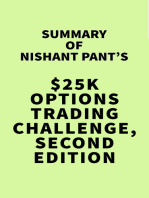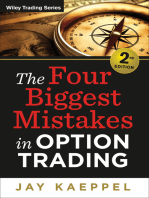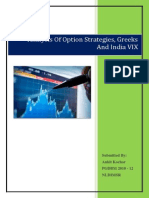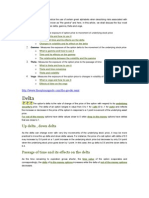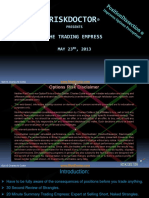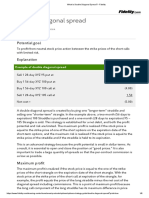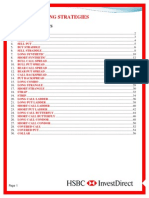Trading and Hedging Options
Uploaded by
naimabdullah2Trading and Hedging Options
Uploaded by
naimabdullah2July 2001
Financial Derivatives
Trading and Hedging Options
July 2001
S.K.Kang
July 2001
Financial Derivatives
Table of Contents
S.K.Kang
Section 1
Option Risks
Section 2
Option Trading Strategies
Section 3
Risk Reversal
Section 4
Summary
July 2001
Financial Derivatives
Section 1
Option Risks
S.K.Kang
July 2001
Financial Derivatives
Option Risks
Dynamic Hedging
Similarities in hedging between
options and a coin-tossing
game in a casino
Self financing
Replicating
Dynamic
Naked Hedging
This is not sitting at the trading desk without wearing a tie
Naked hedging is a nave method of hedging, based on a simple principle: An
option will only be exercised if, on maturity, it is in-the-money
No hedge is maintained when the option is OTM and 100% is hedged when
ITM, all hedging being done at the strike price
This method is usually employed by writers who hope to profit by the entire
premium received. Options are sold as OTM and only hedged when the
underlying price crosses the strike price
This method can be successful (a) when the underlying price never
approaches the strike, and (b) when the underlying price goes through the
strike (100% hedge transacted) and stays ITM without recrossing the strike
One can be lucky with this simple approach, but the underlying price could
easily cross and re-cross the strike several times
Trader may even have some sleepless nights when the underlying price just
sits on the strike
S.K.Kang
July 2001
Financial Derivatives
Option Risks
Dynamic Hedging
Call option:
Current underlying price $99
Strike $100
Volatility 15%
Expiry 1 year
Interest rate 0%
Delta 0.50
S.K.Kang
Performance of Option versus Underlying
Underlying portfolio (Long 50)
Underlying Underlying value
Change in
price
= 50 x price
Underlying value
93.0
4,650
(300)
94.0
4,700
(250)
95.0
4,750
(200)
96.0
4,800
(150)
97.0
4,850
(100)
98.0
4,900
(50)
98.9
4,945
(5)
99.0
4,950
0
99.1
4,955
5
100.0
5,000
50
101.0
5,050
100
102.0
5,100
150
103.0
5,150
200
104.0
5,200
250
105.0
5,250
300
Difference
Option portfolio (Long 100)
Option
Option value
Change in
Outperformance of
price
= 100 x price Option value Option over Underlying
2.93
293
(253)
47
3.28
328
(218)
32
3.67
367
(179)
21
4.07
407
(139)
11
4.51
451
(95)
5
4.97
497
(49)
1
5.41
541
(5)
0
5.46
546
0
0
5.51
551
5
0
5.98
598
52
2
6.52
652
106
6
7.09
709
163
13
7.69
769
223
23
8.30
830
284
34
8.95
895
349
49
July 2001
Financial Derivatives
Option Risks
Dynamic Hedging
The P/L line of the short
underlying position is
displayed as a positive
sloping line but in reality it is
negative.
Performance of Option versus Underlying
400
Underlying portfolio
Option portfolio
300
Illustrated this way, the net
profit is simply the
outperformance measure in
the previous page.
Net profit
200
Profit from
long 100 options
Profit ($)
100
Loss from short
50 underlyings
93
94
(100)
Loss from
long 100 options
95
96
97
98
99
100
101
102
103
104
105
Profit from short
50 underlyings
(200)
Net profit
(300)
(400)
Underlying price ($)
S.K.Kang
July 2001
Financial Derivatives
Option Risks
Dynamic Hedging
Long Gamma Trade
Start with a position that is initially market neutral but that gets long if the
market rises and gets short if the market falls
Long 100 options and simultaneously short 50 underlyings
Small Underlying Price Moves
Market neutral or delta neutral
The fact that, in the future, an
option may be worth
something or nothing, and
that just one price delineates
the boundary between these
two states, gives rise to the
current price being curved.
Large Underlying Price Moves
A curved price profile gives
rise to a constantly changing
exposure to whatever
underlies the option.
If the underlying price rises, the exposure of the option increases above the
constant exposure of the short underlying position and so the total portfolio
automatically becomes long
S.K.Kang
Whichever way the underlying price moves, we always make a profit
The essence of the long gamma trade
The trade works simply because of price curvature and the price profile is
only curved because of the kink on expiry
July 2001
Option Risks
Financial Derivatives
Dynamic Hedging
How to lock in the profits
If the first significant move is up $6 to $105, we have our first mark-tomarket paper profit of $49
The simplest way of locking this profit is to completely liquidate (Sell the
options and buy back the short underlyings)
However, there may be still more profit to be made out of the position
Rehedging process locks in the profit and sets up a situation in which further
profits can be made
To be market neutral again, long 100 options and short 66 underlyings by
selling further 16 underlyings (At $105 the delta is 0.66)
at $99 -5.46x100 + 99x50
at $105 8.95x100 - 105x50
-8.95x100 + 105x66
at $99 5.46x100 - 99x66
-5.46x100 + 99x50
+49
+47
If the underlying price moves from $99 to $105 and back to $99, we sell 16
shares at $105 and buy them back at $99 giving a profit of 16 x (105-99) = $96
$49 profit made in moving from $99 to $105 and $47 in moving from $105
back to $99
The rehedging process forces us always to be in the position of buying low
and selling high
S.K.Kang
July 2001
Financial Derivatives
Option Risks
Dynamic Hedging
Effect of Time Decay
It is not possible to end up with a situation that will always yield a profit
As time passes an option suffers time decay or theta decay
The very options that have little or no time decay (deep OTM or ITM
options) also have very little price curvature
The near-the-money options suffer the most time decay
Options with the most curvature unfortunately suffer the most time decay
800
For the trade to break even, the
price has to move as far $106
in the 3 months
Underlying portfolio
Option with 12 months to expiry
Option with 9 months to expiry
600
Profit ($)
400
200
91
93
95
97
99
101
103
105
107
109
111
(200)
(400)
(600)
S.K.Kang
Underlying price ($)
July 2001
Financial Derivatives
Option Risks
Dynamic Hedging
Effect of Time Decay
The bleed is the change in the
delta and the gamma of an
option position with the
passage of time.
Time Decay Effects on Delta and Gamma
As time passes:
Delta bleed = Delta today
Delta next day
Gamma bleed = Gamma
today Gamma next day
This also shows
the effect of falling
volatilities on
Delta and Gamma
The sensitivity of option prices
to changes in volatility is
similar to the sensitivity to
time. Near-the-money
options are most sensitive
and deep OTM / ITM options
are less sensitive.
OTM
ATM
ITM
Delta
Gamma
Vega Effects on Delta and Gamma
Falling volatilities will have a similar effect to that of time passing
Shorter-dated options have
lower vegas.
S.K.Kang
With increasing volatilities the effects are the reverse
10
July 2001
Financial Derivatives
Option Risks
Dynamic Hedging
Frequency of Rehedging
No rehedging will mean no rehedging profits
We will actually suffer losses due to option time decay
Rehedging more frequently will capture profits due to small price swings but
has the disadvantages of missing out on the really large profits obtained with
large price swings
Two points to consider are the costs of rehedging and the likely time decay
The chosen rehedging strategy will be a question of compromise
S.K.Kang
11
July 2001
Financial Derivatives
Option Risks
Dynamic Hedging
Importance of Curvature - Gamma
One can achieve the same rehedging profit with a smaller underlying price
move using an option with a more marked degree of curvature.
Gamma is the change in delta associated with a change in price of the
underlying
Gamma is a measure of the rate at which we rehedge a delta neutral
position
High gamma options provide more rehedging profits
Gamma is a direct measure of the potential profit due to a change in price
of the underlying
Long gamma refers to the fact that the gamma of the position is positive
S.K.Kang
12
July 2001
Financial Derivatives
Option Risks
Dynamic Hedging
If an option is delta hedged
efficiently on each movement
of the underlying price, and
the actual volatility
experienced over the life of
the option is the same as that
used to calculate the original
premium, then the delta
hedge losses of the option
seller will equal the original
premium received
An Alternative View on Option Fair Value
The idea behind the long gamma trade is to capitalize on future volatility in
the underlying price.
If the option is cheap enough and/or the future volatility is high enough, a
profit results. The strategy generates profits by buying underlying low and
selling high and the overall trade produces a net positive profit if these
rehedging gains exceed the time decay losses.
Short Gamma Trade
Selling low and buying high is a direct result of the fact that the position is
short gamma
Losses will be smaller than those suffered without rehedging
Hedge is used to reduce or remove directional risk
Trade will generate a net profit if the effects of time passing and/or volatility
falling exceed the cost of rehedging
S.K.Kang
13
July 2001
Financial Derivatives
Option Risks
Dynamic Hedging
Vol traders trade vol
Long Options
Short Options
Every option is spot
sensitive
Delta hedge (any traded
option is spot hedged)
Original
Position
Market conditions
change
Long Call
Long Put
Short Call
Short Put
1st Hedge
Sell
1st Hedge
Buy
1st Hedge
Buy
1st Hedge
Sell
Sell
Buy
Buy
Delta changes (Gamma)
Adjust the delta hedge
Underlying
Price Move
Delta
Adjustment
Sell
Buy
Buy
You earn money
through adjustments
S.K.Kang
Sell
Sell
You lose money
through adjustments
14
July 2001
Financial Derivatives
Option Risks
Dynamic Hedging
Monitoring Option Risks
Long 100 calls
vol shift = 1%
time shift = 1 day
underlying price shift = $0.10
At $99:
Delta = (5.512418-5.461963)/0.10
Vega = 5.856885-5.461963
Theta = 5.453842-5.461963
Gamma = 0.50723-0.50455
Long 100 calls + short 50
underlyings
The only difference is in the
EUP and P&L
Since the underlying has no
price curvature or gamma, the
theta risk and vega risk are
unaffected
The sensitivity of an options
portfolio will be the sum of the
individual sensitivities
S.K.Kang
Profit and loss ($)
P&L
P&L
(+vol)
(+time)
(413)
24
(0.50)
(369)
28
(0.57)
(316)
31
(0.64)
(253)
34
(0.70)
(179)
37
(0.75)
(95)
38
(0.79)
0
39
(0.81)
106
40
(0.82)
223
40
(0.81)
349
39
(0.79)
485
37
(0.76)
629
35
(0.72)
781
33
(0.68)
Equivalent underlying position (units)
Equivalent
Gamma
underlying position
20
0.21
24
0.23
29
0.25
34
0.26
39
0.27
45
0.27
50
0.27
56
0.26
61
0.25
66
0.23
70
0.22
74
0.20
78
0.18
Profit and loss ($)
P&L
P&L
(+vol)
(+time)
187
24
(0.50)
131
28
(0.57)
84
31
(0.64)
47
34
(0.70)
21
37
(0.75)
5
38
(0.79)
0
39
(0.81)
6
40
(0.82)
23
40
(0.81)
49
39
(0.79)
85
37
(0.76)
129
35
(0.72)
181
33
(0.68)
Equivalent underlying position (units)
Equivalent
Gamma
underlying position
(30)
0.21
(26)
0.23
(21)
0.25
(16)
0.26
(11)
0.27
(5)
0.27
0
0.27
6
0.26
11
0.25
16
0.23
20
0.22
24
0.20
28
0.18
Underlying
price
87
89
91
93
95
97
99
101
103
105
107
109
111
P&L
Underlying
price
87
89
91
93
95
97
99
101
103
105
107
109
111
P&L
15
July 2001
Financial Derivatives
Option Risks
Dynamic Hedging
Summary of Greeks
Long underlying
Short underlying
Long call
Short call
Long put
Short put
Delta
positive
negative
Gamma
positive
negative
Theta
positive
negative
Vega
positive
negative
S.K.Kang
Delta
(hedge ratio)
positive
negative
positive
negative
negative
positive
Gamma
(curvature)
0
0
positive
negative
positive
negative
Theta
(time decay)
0
0
negative
positive
negative
positive
Vega
(volatility)
0
0
positive
negative
positive
negative
you want the underlying contract to
rise in price
fall in price
you want the underlying contract to
move very swiftly, regardless of direction
move slowly, regardless of direction
the passage of time will generally
increase the value of your position
decrease the vlue of your position
you want volatility to
rise
fall
16
July 2001
Financial Derivatives
Option Risks
Dynamic Hedging
Graphing Positions
positive theta graph shifts
upward over time
negative theta graph shifts
downward over time
positive delta
(graph extends from lower
left to upper right)
negative delta
(graph extends from upper
left to lower right)
positive (negative) vega
graph shifts upward with
higher (lower) volatility
negative (positive) vega
graph shifts downward with
higher (lower) volatility
positive gamma
(a smile)
S.K.Kang
negative gamma
(a frown)
17
July 2001
Financial Derivatives
Section 2
Option Trading Strategies
S.K.Kang
18
July 2001
Financial Derivatives
Option Trading Strategies
4 Basic Trading Positions
What is a typical long gamma trading?
View: Nervous market with frequent moves (e.g., event periods)
Position: Long short term options (i.e., with high gamma and low vega)
Result: Position is more spot than vol sensitive
Frequent delta adjustments are needed
The trader trades spot!
What is a typical long vega trading?
View: Spot reaches new trading ranges
Long known trend is about to reverse
Position: Long long term options (i.e., with high vega and low gamma)
Result: Position is more vol than spot sensitive
Only few delta adjustments should be needed
The trader trades vol!
S.K.Kang
19
July 2001
Option Trading Strategies
Financial Derivatives
4 Basic Trading Positions
Long Gamma
Long Vega
Short Gamma
Long Vega
Long Gamma
Short Vega
Short Gamma
Short Vega
Long
short term
options
Short
short term
options
Long
short term
options
Short
short term
options
Long
long term
options
Strong trend with
important corrections
S.K.Kang
Long
long term
options
Stable market with
long term risks
Short
long term
options
Usually stable
markets with punctual
nervousness
Short
long term
options
Calm after storm
20
July 2001
Financial Derivatives
Option Trading Strategies
Volatility Spreads
Time Spread
4.5
Long Time Spread
4
- long 12m 100 call
3.5
* Long-dated options do suffer
time decay, but at a slower
rate than short-dated ones
Near-the-money:
Long Time Spread price ($)
- short 6m 100 call
2.5
2
1.5
1
12m to expiry
8m to expiry
7m to expiry
6m to expiry
Delta neutral
0.5
Negative gamma
Positive theta
0
80
Positive gamma
Negative theta
S.K.Kang
90
95
100
105
110
115
120
Underlying price ($)
Positive vega
Deep OTM / ITM:
85
Underlying
price
75
79
83
87
91
95
99
103
107
111
115
119
123
Profit and loss ($)
P&L
P&L
P&L
(+vol)
(+time)
(161)
5
(0.09)
(145)
8
(0.12)
(119)
11
(0.12)
(84)
13
(0.04)
(47)
13
0.10
(17)
12
0.25
0
12
0.34
(1)
12
0.32
(17)
13
0.21
(42)
15
0.08
(71)
15
(0.05)
(99)
14
(0.13)
(122)
12
(0.16)
Equivalent underlying position (units)
Equivalent
Gamma
underlying position
3
0.05
5
0.06
8
0.06
9
0.02
9
(0.04)
6
(0.09)
2
(0.11)
(2)
(0.10)
(5)
(0.06)
(7)
(0.02)
(7)
0.01
(6)
0.03
(5)
0.03
21
July 2001
Financial Derivatives
Option Trading Strategies
Volatility Spreads
Strangle
Short Strangle
80
- short 12m 110 call
85
90
95
100
105
110
115
120
-2
- short 12m 90 put
Delta neutral
Negative gamma
Positive theta
Negative vega
Short Strangle price ($)
-4
-6
-8
12m to expiry
6m to expiry
3m to expiry
1m to expiry
expiry
-10
-12
-14
Underlying price ($)
Underlying
price
87
89
91
93
95
97
99
101
103
105
107
109
111
S.K.Kang
Profit and loss ($)
P&L
P&L
(+vol)
(+time)
(283)
(46)
0.94
(192)
(50)
1.03
(119)
(54)
1.11
(63)
(57)
1.17
(25)
(60)
1.23
(4)
(62)
1.27
(0)
(63)
1.30
(14)
(64)
1.31
(45)
(64)
1.32
(91)
(64)
1.31
(153)
(63)
1.28
(230)
(61)
1.25
(320)
(59)
1.21
P&L
Equivalent underlying position (units)
Equivalent
Gamma
underlying position
49
(0.40)
41
(0.42)
32
(0.43)
24
(0.44)
15
(0.44)
6
(0.44)
(3)
(0.43)
(11)
(0.42)
(19)
(0.40)
(27)
(0.38)
(35)
(0.36)
(42)
(0.34)
(48)
(0.32)
22
July 2001
Financial Derivatives
Option Trading Strategies
Volatility Spreads
Characteristics of Volatility Spreads
Volatility spread need not be
exactly delta neutral.
A practical guide is for the
delta to be close enough to
zero so that the volatility
considerations are more
important than the
directional considerations.
Volatility Spread Type
Backspread
Long Straddle
Long Strangle
Short Butterfly
Ratio Vertical Spread
Short Straddle
Short Strangle
Long Butterfly
Long Time Spread
Short Time Spread
Delta
0
0
0
0
0
0
0
0
0
0
Gamma
+
+
+
+
+
Theta
+
+
+
+
+
-
Vega
+
+
+
+
+
-
* Call back spread long more calls at a higher strike (K) than short calls at a lower K
Put back spread long more puts at a lower K than short
Call ratio vertical spread short more calls at a higher K than long
Put ratio vertical spread short more puts at a lower K than long
Long straddle long call and put at the same K
Short straddle short call and put at the same K
Long strangle long put (call) at a lower K and call (put) at a higher K
Short strangle short put (call) at a lower K and call (put) at a higher K
Long butterfly short two calls (puts) at a middle K, long one call (put) at a lower K and one at a higher K
Short butterfly long two calls (puts) at a middle K, short one call (put) at a lower K and one at a higher K
Long time spread long a long-term option and short the same type short-term option at the same K
Short time spread short a long-term option and long the same type at the same K
S.K.Kang
23
July 2001
Financial Derivatives
Option Trading Strategies
Directional Trade
Vertical Spreads
Bull Spread
10
9
12m to expiry
6m to expiry
3m to expiry
1m to expiry
expiry
8
7
Bull Spread price ($)
If a trader focuses initially
on the direction of the
underlying market, he might
look for a spread where the
directional characteristics of
the spread are the primary
concern, and volatility is of
secondary importance
6
5
4
- long 12m 100 call
- short 12m 110 call
2
1
Lower Region:
0
80
85
90
(like a long call)
Positive vega
Upper Region:
(like a short put)
Negative gamma
Positive theta
Negative vega
S.K.Kang
100
105
110
115
120
125
Underlying price ($)
Positive gamma
Negative theta
95
Underlying
price
87
89
91
93
95
97
99
101
103
105
107
109
111
Profit and loss ($)
P&L
P&L
(+vol)
(+time)
(228)
13
(0.26)
(200)
13
(0.27)
(168)
13
(0.27)
(131)
13
(0.26)
(91)
11
(0.23)
(47)
9
(0.19)
(0)
7
(0.14)
48
4
(0.09)
98
1
(0.02)
148
(2)
0.04
197
(5)
0.11
245
(8)
0.17
291
(11)
0.23
P&L
Equivalent underlying position (units)
Equivalent
Gamma
underlying position
13
0.11
15
0.11
17
0.11
19
0.10
21
0.08
23
0.07
24
0.05
25
0.03
25
0.01
25
(0.01)
24
(0.03)
24
(0.05)
23
(0.06)
24
July 2001
Financial Derivatives
Option Trading Strategies
Directional Trade
Risk Reversal
15
Risk Reversal
- long 12m 110 call
12m to expiry
6m to expiry
3m to expiry
1m to expiry
expiry
10
- short 12m 90 put
Initially,
Gamma neutral
Theta neutral
Vega neutral
Risk Reversal price ($)
0
80
85
90
95
100
105
110
115
120
-5
Delta of 50 (a directional trade)
-10
Delta neutral if short 50
underlyings
* Gamma and vega flip from
positive to negative (i.e., risk
switches) across one point
S.K.Kang
-15
Underlying price ($)
Underlying
price
87
89
91
93
95
97
99
101
103
105
107
109
111
Profit and loss ($)
P&L
P&L
(+vol)
(+time)
(652)
(23)
0.47
(531)
(21)
0.43
(416)
(18)
0.37
(307)
(14)
0.29
(202)
(9)
0.19
(100)
(4)
0.08
0
2
(0.04)
102
7
(0.15)
205
13
(0.27)
311
18
(0.37)
422
22
(0.46)
538
26
(0.54)
660
29
(0.59)
P&L
Equivalent underlying position (units)
Equivalent
Gamma
underlying position
63
(0.20)
59
(0.18)
56
(0.14)
53
(0.11)
52
(0.07)
51
(0.03)
50
0.01
51
0.05
52
0.08
54
0.11
57
0.13
59
0.15
62
0.16
25
July 2001
Financial Derivatives
Section 3
Risk Reversal
S.K.Kang
26
July 2001
Financial Derivatives
Risk Reversal
Volatility Smile
The Black & Scholes model used to price options assumes that future spot
rates are lognormally distributed around the forward rate (A variable with a
lognormal distribution has the property that its natural logarithm is normally
distributed)
In reality, extreme outcomes are more likely than the lognormal distribution
suggests - The B&S model underestimates the probability of strong directional
spot movements and therefore undervalues options with low deltas
[2nd Adjustment]
Also, the B&S model does not
take into account any market
trends.
Accordingly, option traders
have to adjust their vol
prices such that strikes lying
in the trend will be more
expensive than the strikes
symmetrical to them
compared to the outright.
S.K.Kang
[1st Adjustment] Traders routinely compensate for these differences by
adjusting the at-the-money-forward vols for out-of-the-money strikes to more
accurately reflect the perceived risk
The manner in which traders adjust the at-the-money volatilities gives rise to
the characteristic smile of the vol curve - This is called the Smile Effect
For example, if the actual distribution shows fatter tails than that suggested
by the lognormal distribution (what is termed excess kurtosis), low delta
options will have been underpriced using B&S
Traders compensate for this by adding a spread above the ATMF vols to both
the low and high strike options
27
July 2001
Financial Derivatives
Risk Reversal
Volatility Smile
In theory, all strikes should
trade at the same vol since
they are all based on the
same underlying instrument.
If you graph implied volatility against the delta of an option, the profile will
look like a smile
The adjustments which traders
make to the ATMF vols in
order to quote high strike or
low strike options result in
the characteristic smile
profile.
Vol
High
Strike
Low
Strike
Smile Effect in a neutral
market:
The market has a neutral bias
towards higher or lower
strikes
ATMF
The price structure is
symmetrical
Only extreme strikes are
adjusted
50
100
Call Delta
100
50
Put Delta
* As a useful guide, remember that the volatility of a 20 delta call is the same as that of an 80 delta put
S.K.Kang
28
July 2001
Financial Derivatives
Risk Reversal
Volatility Smile
Smile Effect in a bullish market:
When high strike options are in
demand, the implied volatilities
need to be adjusted higher
Vol
The price structure is asymmetrical
High
Strike
The market favors higher strikes
(OTM Calls)
Low
Strike
Smile Effect in a bearish market:
When low strike options are in
demand, the implied volatilities
need to be adjusted higher
ATMF
The price structure is asymmetrical
The market favors lower strikes
(OTM Puts)
Since the curve may be shaped like a
lop-sided smile or a smirk or a
frown, people have been using the
term volatility skew instead of
volatility smile because the term
skew doesnt imply the sort of
symmetry that the term
smiledoes.
A smile curve can be defined for
every maturity. We may have a
rather neutral sentiment on the
short term but a bullish view on the
long term. Check the concept of
volatility surface (strike x
maturity x vol)
S.K.Kang
50
100
100
50
Call Delta
Put Delta
Vol
High
Strike
Low
Strike
ATMF
50
100
100
50
Call Delta
Put Delta
29
July 2001
Financial Derivatives
Risk Reversal
Risk Reversal - Definition & Quotation
* Instead of quoting exercise
prices directly, the convention
in the options market is to quote
prices for options with
particular deltas. Like the
practice of quoting implied
volatilities, the rationale for this
is to allow comparison of
quotes without needing to take
into account changes in the
underlying price. When referring
to the delta of options, market
participants also drop the sign
and the decimal point of the
delta. So for example, an OTM
put option with a B&S delta of
Now that it is clear how and why high strike and low strike vols differ from the
ATMF vols, it becomes important to understand how this is measured or obtained in
the market
-0.25 is referred to as a 25-delta
put.
As options with the same delta have the same sensitivity to the vol (or same vega),
risk reversals are vega neutral
A 25-delta risk reversal is
obtained by buying a 25-delta
option and selling a 25-delta
option in the opposite
direction
The risk reversal is the volatility spread between the level of vol quoted in the
market for a high strike option and the vol for a low strike option
Risk reversals are collars, where the bought option and the sold option have the
same delta
As a vega neutral structure, the vol spread will be more important than the actual
vol level
R/R are quoted as vol spreads
They will also have to reflect an eventual asymmetry of the Smile Effect
In this example, the OTM call is
more expensive than the
equally OTM put (compared
with what would be predicted
by the B&S model)
S.K.Kang
The market convention is to quote the difference between 25 delta strikes, however
any other delta may be priced
So, ignoring bid offer, if the vol of a 25 delta JPY put is 10.80%, and if the vol of a
25 delta JPY call is 11.20%, then the risk reversal would be quoted as 0.40, JPY
calls over, indicating that JPY calls are favored over JPY puts (a skewness towards
a large yen appreciation)
30
July 2001
Financial Derivatives
Risk Reversal
Risk Reversal - Definition & Quotation
R/R shows what direction the
market is favoring
Example
R/R also gives an indication of
the strength of the markets
expectations
USD/JPY 1 Month 25 Delta R/R
R/R indicates the degree of
skewness compared with the
lognormal distribution, which
itself is positively skewed
Vol 1M ATM: 9.5/9.8
0.1/0.3 USD Puts
Traders need to reach an
agreement on the actual level
of volatilities for the call and
put when trading R/R
To translate risk reversal
quotes into actual vols, one
requires information on
strangles or butterflies
S.K.Kang
Shows what the
trader favors
Bid:
Trader buys USD Put 9.6
& sells USD Call 9.5
i.e. he pays 0.1% vol away
Offer:
Trader sells USD Put 9.8
& buys USD Call 9.5
i.e. he receives 0.3% vol
31
July 2001
Financial Derivatives
Risk Reversal
Risk Reversals, Strangles and Butterflies
Standard option strategies are
usually constructed using 25 or
10 delta options
The three most commonly quoted
strategies are risk reversals,
strangles and butterflies
When the butterfly (or the strangle
quoted as a spread over ATMF
vol) is positive, this indicates
that the OTM options are more
expensive than the B&S model
would suggest. This is
indicative of a fat-tailed
distribution.
A 25 delta strangle is obtained by buying (or selling) a 25 delta call and a 25
delta put
Strangles are quoted in absolute volatility terms as the average of call and
put volatilities (often expressed as a spread over ATMF vol)
A long 25 delta butterfly is the combination of a short ATMF straddle and a
long 25 delta strangle
Butterflies are quoted as a spread between the strangles and the straddles
Observing both the risk reversal and the strangle (or the butterfly) allows the
calculation of two separate volatilities for the call and put
For example, from the following mid-market information,
In the example, Strangle = (Vol for
the call + Vol for the put) / 2 =
(11.1 + 10.1) / 2 = 10.6
ATMF vol = 10.0
Butterfly (or Strangle quoted as a spread over ATMF vol) = 0.6
R/R = 1.0 call over
Strangle = 10.0 + 0.6 = 10.6
Vol for the call = 10.6 + 1.0 / 2 = 11.1
Vol for the put = 10.6 1.0 / 2 = 10.1
S.K.Kang
32
July 2001
Financial Derivatives
Risk Reversal
Risk Reversal - Interpretation
One Impact of the R/R on
Pricing:
One can ask oneself whether a preference to hold or demand calls or puts (or
vice versa) gives any predictive capability on the direction of underlying
If high strikes are favored
over low strikes, the
additional expense of the
high strike versus the low
strike option is particularly
apparent when pricing zero
cost collars
The Fed has investigated whether the R/R has any predictive capability and
has found that the risk neutral moments implied by option prices and
extracted from them ... match actual realizations fairly well, but episodically
fail to predict the range of possible future exchange rates.
As the individual strikes of
the collars move away from
the forward level, the
differences between each
strike and the forward level
become more asymmetric
In other words, one has to
move the high strike level
farther away (from the
forward level) than the move
in the low strike in order to
maintain a net zero cost
The R/R can be sometimes a good indicator, as they reflect a punctual
consensus
However, the R/R is a better indicator of how the vol will move in the future
It does give a sense for where future vol levels are expected to be if the
underlying were to make a significant move one way or the other
Therefore, one has to be aware of the strikes corresponding to the 25 deltas of
the R/R
These 25 delta strikes may be at technical or psychological resistance or
support levels
Such a sensitivity to a particular level will be reflected in the vol skew made
by the options traders and thus the risk reversal market value
The R/R is a measure of the risk that options traders assign to these particular
strikes
S.K.Kang
33
July 2001
Financial Derivatives
Section 4
Summary
S.K.Kang
34
July 2001
Financial Derivatives
Summary
References
Buying and Selling Volatility - Kevin B. Connolly (Wiley, 1997)
Option Volatility & Pricing Sheldon Natenberg (Probus, 1994)
Foreign Exchange Options Alan Hicks (Woodhead, 1993)
Dynamic Hedging Nassim Taleb (Wiley, 1997)
Black-Scholes and Beyond Neil A. Chriss (Irwin, 1997)
S.K.Kang
35
You might also like
- Trading Implied Volatility: Extrinsiq Advanced Options Trading Guides, #4From EverandTrading Implied Volatility: Extrinsiq Advanced Options Trading Guides, #44/5 (1)
- Brian Johnson Option Strategy Risk Return Ratios: A Revolutionary New Approach To Optimizing, Adjusting, and Trading Any Option Income Strategy100% (16)Brian Johnson Option Strategy Risk Return Ratios: A Revolutionary New Approach To Optimizing, Adjusting, and Trading Any Option Income Strategy183 pages
- Summary of Nishant Pant's $25K Options Trading Challenge, Second EditionFrom EverandSummary of Nishant Pant's $25K Options Trading Challenge, Second EditionNo ratings yet
- Option Strategy Cheat Sheet: Condition Volatility Skew Time Notes33% (3)Option Strategy Cheat Sheet: Condition Volatility Skew Time Notes1 page
- Bullshi T Free Guide To Option Volatility by Gavin McMaster100% (1)Bullshi T Free Guide To Option Volatility by Gavin McMaster84 pages
- Option Greeks in Plain English Mastery in Place Steven67% (6)Option Greeks in Plain English Mastery in Place Steven267 pages
- Options For Volatility: Sample Investing Plans100% (1)Options For Volatility: Sample Investing Plans10 pages
- Mastering Option Trading Volatility Strategies With Sheldon Natenberg80% (5)Mastering Option Trading Volatility Strategies With Sheldon Natenberg31 pages
- Power: Passive Option Writing Exceptional Return StrategyFrom EverandPower: Passive Option Writing Exceptional Return StrategyNo ratings yet
- Uncle Bobs Money: Generating Income with Conservative Options TradesFrom EverandUncle Bobs Money: Generating Income with Conservative Options Trades4/5 (6)
- Credit Spreads:Beginners Guide to Low Risk, Secure, Easy to Manage, Consistent Profit for Long Term WealthFrom EverandCredit Spreads:Beginners Guide to Low Risk, Secure, Easy to Manage, Consistent Profit for Long Term WealthNo ratings yet
- Analysis of Option Strategies, Greeks-Ankit Kochar100% (5)Analysis of Option Strategies, Greeks-Ankit Kochar60 pages
- How To Profit From Theta When Trading SPX Options Business News Minyanville's Wall StreetNo ratings yetHow To Profit From Theta When Trading SPX Options Business News Minyanville's Wall Street4 pages
- Option Income Strategies Overview/Survey: Raleigh-Durham Traders Meetup 1/11/2017100% (3)Option Income Strategies Overview/Survey: Raleigh-Durham Traders Meetup 1/11/201750 pages
- High Probability Option Trading Covered Calls and Credit Spread75% (4)High Probability Option Trading Covered Calls and Credit Spread69 pages
- December 3, 2013uncategorized: Floating With The Modified Butterfly Spread100% (2)December 3, 2013uncategorized: Floating With The Modified Butterfly Spread81 pages
- The New Option Secret - Volatility: The Weapon of The Professional Trader and The Most Important Indicator in Option Trading (PDFDrive)100% (3)The New Option Secret - Volatility: The Weapon of The Professional Trader and The Most Important Indicator in Option Trading (PDFDrive)329 pages
- Option Greeks and Management of Market Risk100% (1)Option Greeks and Management of Market Risk14 pages
- Trading The Volatility Skew of The Options On The SP Index PDF100% (2)Trading The Volatility Skew of The Options On The SP Index PDF41 pages
- Dan Sheridan Adjust Condors in Volatile Market100% (2)Dan Sheridan Adjust Condors in Volatile Market49 pages
- What Is Double Diagonal Spread - FidelityNo ratings yetWhat Is Double Diagonal Spread - Fidelity8 pages
- Advanced Option Strategies For Active InvestorsNo ratings yetAdvanced Option Strategies For Active Investors70 pages
- Option Market Making : Part 1, An Introduction: Extrinsiq Advanced Options Trading Guides, #3From EverandOption Market Making : Part 1, An Introduction: Extrinsiq Advanced Options Trading Guides, #3No ratings yet
- A Collection of High School Vector ProblemsNo ratings yetA Collection of High School Vector Problems2 pages
- Handwritten Javanese Script Recognition Method Based 12-Layers Deep Convolutional Neural Network and Data AugmentationNo ratings yetHandwritten Javanese Script Recognition Method Based 12-Layers Deep Convolutional Neural Network and Data Augmentation11 pages
- 32.power System Study-Sc, RC & Dynamic Testing100% (2)32.power System Study-Sc, RC & Dynamic Testing136 pages
- Powerone, Power Supply 48V Rectifier Module (Aspiro XR08.48)No ratings yetPowerone, Power Supply 48V Rectifier Module (Aspiro XR08.48)3 pages
- EMV of ALTERNATIVES - Final RequirementNo ratings yetEMV of ALTERNATIVES - Final Requirement28 pages
- Holt Algebra 2 Homework and Practice Workbook Answers100% (1)Holt Algebra 2 Homework and Practice Workbook Answers4 pages
- Likelihood Ratio Tests: Instructor: Songfeng ZhengNo ratings yetLikelihood Ratio Tests: Instructor: Songfeng Zheng9 pages
- [FREE PDF SAMPLE] Mechanics of Materials Brief Edition James M. Gere ebook full chapters100% (2)[FREE PDF SAMPLE] Mechanics of Materials Brief Edition James M. Gere ebook full chapters86 pages
- Application of Integrals: Date: ..............No ratings yetApplication of Integrals: Date: ..............8 pages
- Trading Implied Volatility: Extrinsiq Advanced Options Trading Guides, #4From EverandTrading Implied Volatility: Extrinsiq Advanced Options Trading Guides, #4
- Brian Johnson Option Strategy Risk Return Ratios: A Revolutionary New Approach To Optimizing, Adjusting, and Trading Any Option Income StrategyBrian Johnson Option Strategy Risk Return Ratios: A Revolutionary New Approach To Optimizing, Adjusting, and Trading Any Option Income Strategy
- Summary of Nishant Pant's $25K Options Trading Challenge, Second EditionFrom EverandSummary of Nishant Pant's $25K Options Trading Challenge, Second Edition
- Option Strategy Cheat Sheet: Condition Volatility Skew Time NotesOption Strategy Cheat Sheet: Condition Volatility Skew Time Notes
- Bullshi T Free Guide To Option Volatility by Gavin McMasterBullshi T Free Guide To Option Volatility by Gavin McMaster
- Option Greeks in Plain English Mastery in Place StevenOption Greeks in Plain English Mastery in Place Steven
- Mastering Option Trading Volatility Strategies With Sheldon NatenbergMastering Option Trading Volatility Strategies With Sheldon Natenberg
- Power: Passive Option Writing Exceptional Return StrategyFrom EverandPower: Passive Option Writing Exceptional Return Strategy
- Equity Options Trading For Complete BeginnersFrom EverandEquity Options Trading For Complete Beginners
- Uncle Bobs Money: Generating Income with Conservative Options TradesFrom EverandUncle Bobs Money: Generating Income with Conservative Options Trades
- Credit Spreads:Beginners Guide to Low Risk, Secure, Easy to Manage, Consistent Profit for Long Term WealthFrom EverandCredit Spreads:Beginners Guide to Low Risk, Secure, Easy to Manage, Consistent Profit for Long Term Wealth
- Analysis of Option Strategies, Greeks-Ankit KocharAnalysis of Option Strategies, Greeks-Ankit Kochar
- How To Profit From Theta When Trading SPX Options Business News Minyanville's Wall StreetHow To Profit From Theta When Trading SPX Options Business News Minyanville's Wall Street
- Option Income Strategies Overview/Survey: Raleigh-Durham Traders Meetup 1/11/2017Option Income Strategies Overview/Survey: Raleigh-Durham Traders Meetup 1/11/2017
- High Probability Option Trading Covered Calls and Credit SpreadHigh Probability Option Trading Covered Calls and Credit Spread
- December 3, 2013uncategorized: Floating With The Modified Butterfly SpreadDecember 3, 2013uncategorized: Floating With The Modified Butterfly Spread
- The New Option Secret - Volatility: The Weapon of The Professional Trader and The Most Important Indicator in Option Trading (PDFDrive)The New Option Secret - Volatility: The Weapon of The Professional Trader and The Most Important Indicator in Option Trading (PDFDrive)
- Trading The Volatility Skew of The Options On The SP Index PDFTrading The Volatility Skew of The Options On The SP Index PDF
- Option Market Making : Part 1, An Introduction: Extrinsiq Advanced Options Trading Guides, #3From EverandOption Market Making : Part 1, An Introduction: Extrinsiq Advanced Options Trading Guides, #3
- Handwritten Javanese Script Recognition Method Based 12-Layers Deep Convolutional Neural Network and Data AugmentationHandwritten Javanese Script Recognition Method Based 12-Layers Deep Convolutional Neural Network and Data Augmentation
- Powerone, Power Supply 48V Rectifier Module (Aspiro XR08.48)Powerone, Power Supply 48V Rectifier Module (Aspiro XR08.48)
- Holt Algebra 2 Homework and Practice Workbook AnswersHolt Algebra 2 Homework and Practice Workbook Answers
- Likelihood Ratio Tests: Instructor: Songfeng ZhengLikelihood Ratio Tests: Instructor: Songfeng Zheng
- [FREE PDF SAMPLE] Mechanics of Materials Brief Edition James M. Gere ebook full chapters[FREE PDF SAMPLE] Mechanics of Materials Brief Edition James M. Gere ebook full chapters




